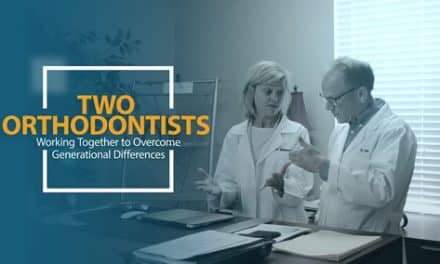Remote monitoring tools and virtual consults are key to providing continuity of care and securing new patients as daily routines change
Both orthodontic practices and their patients are stressed. The coronavirus (COVID-19) pandemic is swiftly changing daily routines. And as people start to hunker down to control the spread, practices have questions about how to provide continuity of care to existing patients while securing new patients.
Tools that allow for remote monitoring or virtual consults are going to be key, says Amanda Wilson, DDS, MDS, CEO and founder of StraightSmile Solutions, an online portal providing doctor-to-doctor orthodontic consulting services.
Orthodontic Products spoke to Wilson, a former orthodontist in private practice, about the role virtual technology can play, how aligners might be the ideal treatment modality in these uncertain times, why it’s important to use this time to build your practice for the future, and why this might be an opportunity to get a leg up on the direct-to-consumer aligner companies.
Orthodontic Products: When it comes to new case starts at this time, what are your treatment recommendations?
Amanda Wilson, DDS, MDS: Now is the time, if there is a choice, to have more patients in removables than fixed. It’s significantly easier and it can be managed remotely. You don’t even have to do the attachments at the first visit. You could do them 2 months down the road. But you can start the case and at least have revenue floating in.
I think one of the biggest mistakes orthodontists make is that they charge a premium price or an additional upgrade fee for aligners. I realize braces are fundamentally cheaper because we buy them in bulk, and they don’t have an associated lab fee. But we don’t know how long this outbreak is going to last. This might be a few months. It might be a year. So if I had a choice right now, if I had my practice again, and when I advise orthodontists, I say, just do as many aligners as possible because it’s feasible to do an aligner case in just three visits; and it can be managed remotely. Don’t think about the lab fee right now, because your doctor time is at a premium and way more valuable. Let’s just try to get these patients taken care of.
OP: What tools or services do you recommend orthodontists use to monitor their patients?
Wilson: There are some turnkey services out there that have been around for some time, like Dental Monitoring. I know a lot of doctors that use it. But there are other products that don’t use artificial intelligence (AI) that offer a cheaper option. You’ve got all the time in the world right now if your practice is slowing down or closing; so does your staff—and we need to keep them busy. It’s one thing if we’re super busy—we need to have a computer do things for us; but right now we’re not. So personally, I say cut out the AI. You’ve got plenty of intelligence within your own team and your staff, so go with a service that maybe just has a flat fee. There are a couple out there, including GP Ortho Tracking.
For patients who can’t come in for an in-office appointment, at least offer them a virtual appointment. Zoom for Healthcare [the video and web conferencing platform] offers a HIPAA-compliant option that allows you to speak to a patient in a one-on-one private meeting—like a regular 15-minute appointment. No, maybe you’re not changing wires; but, for most appointments, you don’t need to do that. You’re just checking to make sure everything is going well. If worse comes to worst, they can come in and get a wire clipped or something like that. Let’s still maintain our status quo and let’s still take care of our patients.
OP: How should practices handle new patient consults during the coronavirus pandemic?
Wilson: It’s all about virtual consults. As a mom of teenagers, I have a pretty good pulse of what’s going on with parents with school-aged kids. They are asking me: How do I handle my child’s orthodontics? That’s a huge issue right now. They’re also worried about what they can do if they want to start treatment. I’m telling them find someone that has virtual consults. And that’s exactly what they’re doing. They are googling “virtual orthodontic consults.”
There are some turnkey programs—including SmileSnap. That one’s been around for a few years. There’s no AI on that because it’s a widget that you plug into your own website. If anyone wants to demo it, I actually have it plugged into my own website. GP Ortho Tracking has a virtual consult widget as well. But you can use any HIPAA-compliant platform. It’s up to you. Do you want to have an app? Or do you want to have a widget on your website? Two different things.
OP: If you offer virtual consults, how should you promote that service now?
Wilson: If people are googling “virtual orthodontic consults,” you’re going to need to update your SEO and maybe create some content around it so that Google can find it. Because if they don’t find it, prospective patients and parents don’t know that you have it.
We have all the time in the world to create content right now, and content is free. If you’re taking progress pictures or have patients who have completed treatment, that’s content right there. If you don’t have social media releases, reach out to your patients now. Send them an email. Check to see how they’re doing. Get those releases and start creating content.
Right now, there’s a huge percentage of patients and people on social media. Facebook, Instagram—the numbers are going way up. People are actually spending time on these platforms. They’re looking for thoughtful content. So, this is a great time to just reach out. Show your great work. Talk about your virtual consults. Tell your followers that you are still seeing patients, accepting new patients, and that you are there for them.
OP: What’s your advice to practices that may see a slowdown?
Wilson: This is the time to act decisively and come up with a plan. Let’s keep your team busy. Please, please, don’t lay off your team if you can. There are so many things that you probably have procrastinated on. Now’s the time you could do it and it will pay off for you later. In the short run, it might be a little tight, but there’s just so many things I know you can do. And I’m happy to talk to any orthodontists out there. I can give them five suggestions that really won’t cost anything that they should do to keep everyone busy right now, but that later have a huge ROI.
Let’s hunker down, but let’s not just sit and watch Netflix. Let’s do things that will help to give us a foothold, so when we come out of this, we’re coming out ahead. We don’t want the industry to go down.
OP: We’ve talked a lot about remote monitoring and virtual consults—two tools that are heavily used by direct-to-consumer aligner companies, like SmileDirectClub, which I know you initially had a hand in setting up. Is this an opportunity for orthodontic practices to better position themselves to keep patients under the direct care of an orthodontist?
Wilson: Absolutely. What I helped start with SmileDirectClub is not what you see now. Admittedly, a lot of people don’t like me for my role. But I am no longer associated with the company, and I am here to help orthodontists now. If orthodontists don’t change the way they’re doing things, this is going to be a huge boon for SmileDirectClub. I’m just saying: Don’t complain if you have this opportunity to do things a little bit different.
With everything going on today, patients are looking at the direct-to-consumer aligner companies and seeing that they offer remote consults and that you don’t have to go into an office. People like the convenience of SmileDirectClub. So, let’s be convenient. Here’s an opportunity to change. Implement virtual consults and remote monitoring. And market that your practice uses these tools. You’re not changing the quality of the care you provide to your patients. You’re making it more convenient. OP
For information on how to prepare your orthodontic practice to protect staff and patients, check out our recent article: Preparing the Orthodontic Practice for Coronavirus.










